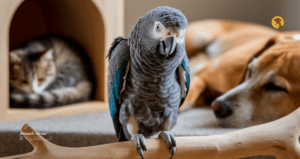Cat Hair Loss Causes – The information provided in this article is for educational purposes only and is not a substitute for professional veterinary advice. Always consult your veterinarian for concerns about your cat’s health.
Understanding Cat Losing Hair Causes
Feline hair loss, also known as cat alopecia, can be distressing for both the pet and its owner. Cats naturally shed fur, but excessive shedding, bald spots, or thinning fur can indicate underlying health issues. From allergies and stress to infections and hormonal imbalances, multiple factors contribute to hair loss in cats.
Identifying the root cause is crucial for effective treatment. By understanding the various conditions that lead to hair loss, cat owners can take preventive measures and ensure their feline friend maintains a healthy, shiny coat.
Common Cat Shedding Causes
Normal shedding is part of a cat’s natural grooming cycle. However, excessive shedding could point to:
- Seasonal Shedding: Cats tend to shed more during spring and fall.
- Poor Diet: Lack of essential nutrients like Omega-3 fatty acids can lead to brittle fur and excessive shedding.
- Age: Older cats may lose hair due to decreased skin elasticity and poor grooming habits.
- Over-Grooming: Anxiety or stress can cause compulsive licking, leading to bald patches.
Bald Spots on Cats: When to Worry
While some hair thinning is normal, bald spots often indicate underlying health issues such as:
- Parasites (Fleas, Mites, Ticks): Infestations lead to severe itching, scratching, and hair loss.
- Ringworm: This fungal infection causes circular bald patches with scaly skin.
- Allergies: Cats can develop allergies to food, pollen, or household products, causing skin irritation and hair loss.
- Hormonal Imbalances: Conditions like hyperthyroidism can trigger excessive shedding.
If your cat has unexplained bald spots, a veterinarian visit is essential for proper diagnosis and treatment.
Feline Hair Loss Treatment: What Can Be Done?
Treatment depends on the underlying cause. Here’s how different conditions are managed:
- Parasites: Flea prevention treatments and medicated shampoos help eliminate infestations.
- Fungal Infections: Antifungal medications, shampoos, and environmental cleaning are necessary.
- Allergies: Identifying and eliminating allergens, along with antihistamines, can reduce symptoms.
- Hormonal Disorders: Veterinarians may prescribe medications to regulate hormone levels.
Consistent grooming, regular check-ups, and a balanced diet play a crucial role in preventing hair loss.
Cat Skin Conditions That Lead to Hair Loss
Skin diseases are a major contributor to feline alopecia. Some common conditions include:
- Mange in Cats: Caused by mites, leading to intense itching and hair loss.
- Fungal Infections: Ringworm and yeast infections cause bald patches and scaly skin.
- Bacterial Infections: Staph infections and abscesses may lead to localized hair loss.
Identifying skin conditions early and seeking prompt treatment can prevent further complications.
Preventing Cat Losing Hair: Proactive Measures
While some hair loss causes are unavoidable, preventive steps can help maintain a healthy coat:
- Regular Vet Check-Ups: Early detection of health issues prevents severe hair loss.
- Balanced Nutrition: A high-quality diet rich in vitamins, minerals, and Omega-3 fatty acids strengthens the coat.
- Flea Control: Use vet-recommended flea preventatives to avoid infestations.
- Stress Management: Provide a stimulating environment and maintain a routine to reduce anxiety-induced over-grooming.
Proper grooming reduces shedding and prevents skin infections. Here’s what you can do:
Cat Grooming Tips for a Healthy Coat
- Brush Regularly: Short-haired cats benefit from weekly brushing, while long-haired breeds require daily grooming.
- Bathe Occasionally: Use cat-friendly shampoos to remove dirt and allergens.
- Check for Skin Issues: Inspect your cat’s coat for bald patches, redness, or signs of irritation.
FAQs
Sudden hair loss may be due to stress, allergies, or infections. If your cat experiences rapid hair loss, seek veterinary advice.
Yes, food allergies can trigger skin irritation and hair loss. Switching to a hypoallergenic diet may help.
Shedding is normal, but excessive hair loss accompanied by bald patches or itching could indicate a health problem.
Regular grooming, a healthy diet, and flea prevention can help manage mild hair loss. However, for persistent issues, consult a vet.
Yes, indoor cats can develop hair loss due to stress, dry air, or nutritional deficiencies.







